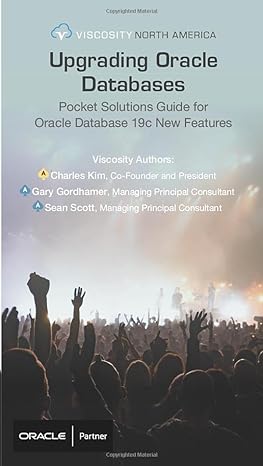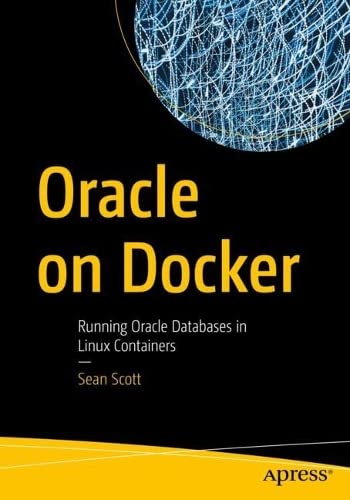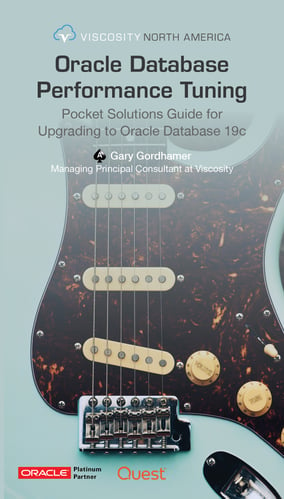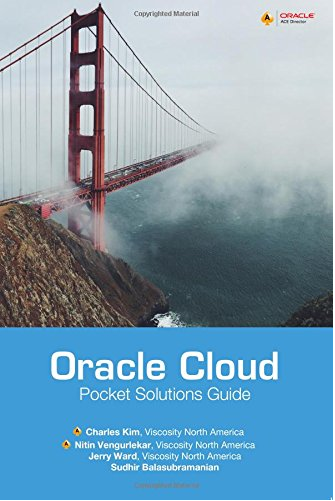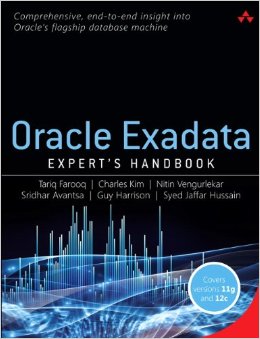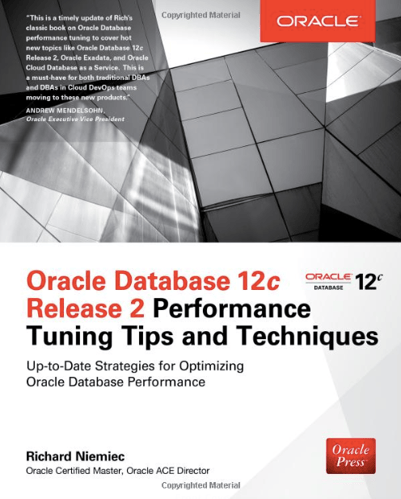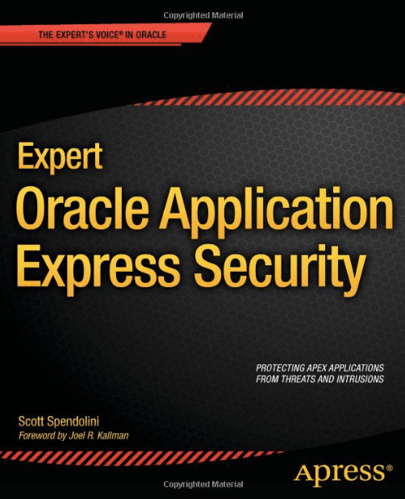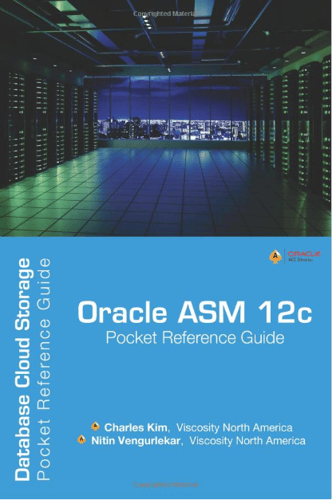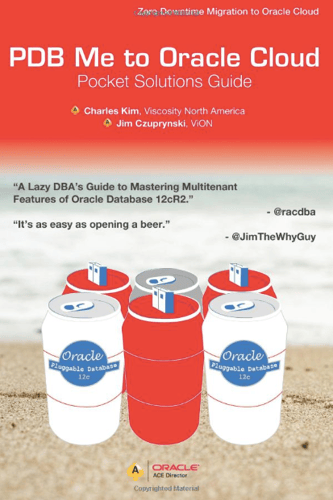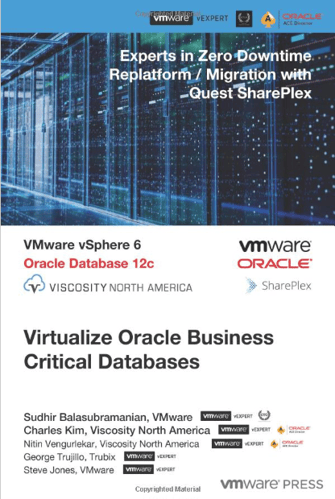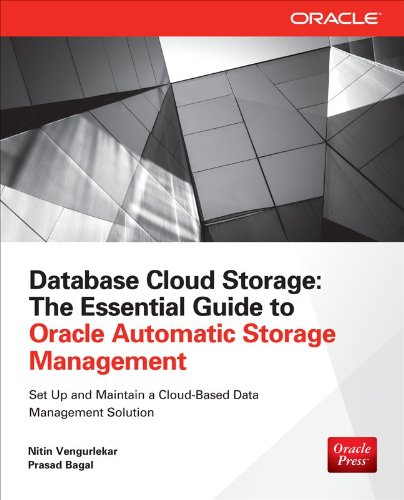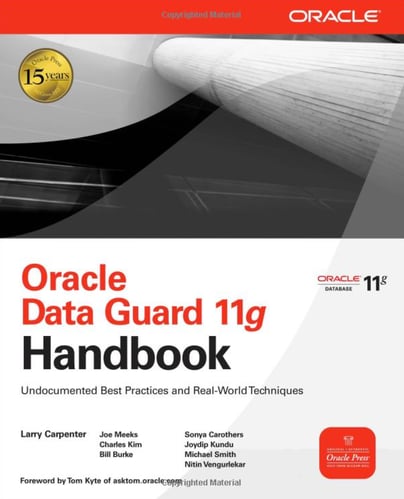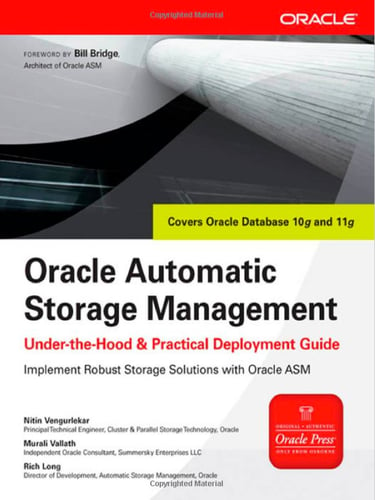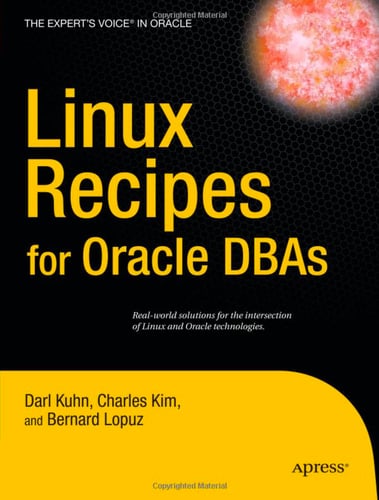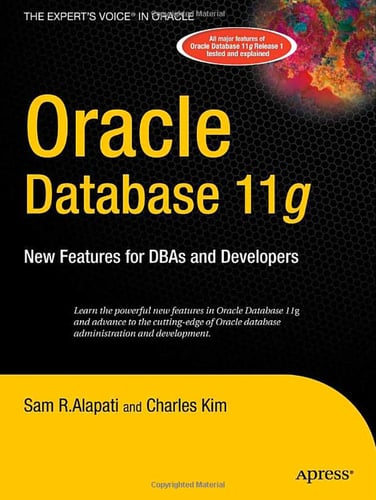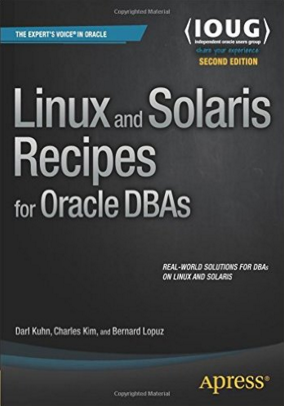Viscosity Publications
Oracle continues to innovate and add new features constantly. Learn from the experts who perform upgrades all the time on how to perform database upgrades to Oracle Database 19c. This book covers a lot of the pertinent Oracle database new features in Oracle Database 18c/19c.
The authors of this book travel and speak at all the major conferences in the USA and have ventured off to Europe, Asia, and Australia sharing their upgrade and performance tuning experiences.
Discover the benefits of running Oracle databases in Linux containers. This book approaches containers from the perspective of database administrators, developers, and systems administrators. It explains the differences between containers and virtual machines and describes why containers deliver greater speed, flexibility, and portability, with lower resource requirements. You’ll learn how running Oracle databases in containers complements existing database infrastructure and accelerates development, and you’ll understand the advantages they offer for test and validation environments.
This book teaches you how to begin working with Oracle databases in Docker, covering the steps for preparing and installing software on Windows, Mac, and Linux systems. It describes the steps for deploying Oracle databases, separating data and configurations from database software, and networking and communicating with your containers. It introduces the Docker commands you’ll use for managing containers, including tips and shortcuts to make everyday tasks easier. Databases have unique demands for performance and reliability, and this book addresses those qualities with discussions on protecting, persisting, and distributing data. Other books may overlook these topics and approach containers as disposable commodities in serverless environments or convenient coding platforms. You’ll gain battle-tested insights for customizing and extending your containers to meet different needs.
If you are an Oracle Database Administrator, you can expect to encounter many storms in your career. Upgrading and dealing with performance issues, software changes, hardware changes, and even application changes can feel like a perfect storm.
This book won’t provide you everything you need for a perfect storm. Hopefully it gets you started down the right path and provides the daily knowledge to solve many problems. This might become your trusty snow shovel.
To clarify, we have prepared this material which includes approaches, instructions, examples, definitions, best practices, lessons learned and sample scripts to give you the basic insights needed to tune Oracle 19c Databases. Many of the topics contained herein are extracted from our collective real-world experiences. A few topics are more of a discussion giving you something to ponder and think about in how to approach a situation. Other topics would require a much deeper dive than a pocket reference would allow; including tuning of RAC Cluster, Storage, Networking, Operating Systems, RDBMS Internals to name a few. Those are the times when you will need to dig in deep and have more tools at your disposal for blizzard situations.
As Cloud Computing has evolved and matured, it has sparked a growing interest in the enterprise market, where economic pressures challenge traditional IT operations. Many companies and government agencies face growing IT cost that originate from multiple sources such as legacy systems, software licensing, power consumption, and operating overhead. Cloud Computing, either through Private or Public cloud initiatives, is focused on addressing these issues by reducing costs through better standardization, higher utilization, greater agility, and faster responsiveness of IT services. Oracle is heavily invested in cloud initiatives and is looking to be one of the leaders in the magic quadrant. Oracle is aiming at contending for the AWS market share just like Microsoft Azure was able to obtain. Oracle has planted data centers in strategic locations worldwide for its cloud infrastructure. Oracle has robust offerings in SaaS, PaaS, and IaaS. In the SaaS space, Oracle already had a strong presence. Even though Oracle continues to invest in its SaaS environment, Oracle has invested significantly in the past couple of years to capture more of the market in the PaaS and IaaS space. This book will address Oracle Cloud fundamentals, Storage Cloud, Database Cloud, and Oracle Database Backup Cloud as a quick go-to reference guide, as seen by industry experts.
Spanning both ends of the database family spectrum, a run-away success, the blazingly fast Oracle Exadata Database Machine has been embraced by thousands of users worldwide — in government, the military, the large corporate enterprise to small business operations. Whether it is mundane day-to-day database-centric operations or in ecosystems that require nothing less than "extreme" database performance coupled with maximum levels of high availability in VLDB environments, Exadata has proved to be a viable and successful solution. The Oracle Exadata Expert's Handbook is today's most authoritative and practical guide to administering Oracle Exadata with maximum reliability, effectiveness, performance, and efficiency. Written by a consortium of internationally respected independent Oracle technology experts, it brings together core day-to-day knowledge, experiences, best practices, tips, and tricks you won't find anywhere else. Covering 11g and 12c versions of the underlying Oracle Exadata software, it provides hands-on, step-by-step coverage of all this and more.
Proven Database Optimization Solutions―Fully Updated for Oracle Database 12c Release 2
Systematically identify and eliminate database performance problems with help from Oracle Certified Master Richard Niemiec. Filled with real-world case studies and best practices, Oracle Database 12c Release 2 Performance Tuning Tips and Techniques details the latest monitoring, troubleshooting, and optimization methods. Find out how to identify and fix bottlenecks on premises and in the Cloud, configure storage devices, execute effective queries, and develop bug-free SQL and PL/SQL code. Testing, reporting, and security enhancements are also covered in this Oracle Press guide.
- Properly index and partition Oracle Database 12c Release 2
- Work effectively with Oracle Cloud, Oracle Exadata, and Oracle Enterprise Manager
- Efficiently manage disk drives, ASM, RAID arrays, and memory
- Tune queries with Oracle SQL hints and the Trace utility
- Troubleshoot databases using V$ views and X$ tables
- Create your first cloud database service and prepare for a hybrid Cloud
- Generate reports using Oracle’s Statspack and Automatic Workload Repository tools
- Use sar, vmstat, and iostat to monitor operating system statistics
Expert Oracle Application Express Security covers all facets of security related to Oracle Application Express (APEX) development. From basic settings that can enhance security to preventing SQL Injection and Cross Site Scripting attacks, Expert Oracle Application Express Security shows how to secure your APEX applications and defend them from intrusion. Security is a process, not an event. Expert Oracle Application Express Security is written with that theme in mind. Scott Spendolini, one of the original creators of the product, offers examples of security best practices and provides step-by-step instructions on how to implement the presented recommendations. A must-read for even the most experienced APEX developer, Expert Oracle Application Express Security can help your organization ensure their APEX applications are as secure as they can be.
You will learn to:
- Devise and execute a security plan
- Ensure your installation of APEX is configured most securely
- Prevent SQL Injection, cross-site scripting, and URL tampering attacks
- Protect your data during all phases of its lifetime
- Apply security features built into the database layer
- Design APEX applications to safely be deployed on the Internet
This book is aimed at developers and administrators deploying applications created using Oracle Application Express (APEX). The topic is especially important when those applications are public-facing or involve sensitive data. Any APEX developer or administrator who wants to sleep well at night, in an era of network intrusion and data thievery, will want this book.
Oracle ASM continues to be the best practice for implementing Oracle Databases. Whether leveraging a single instance database or a clustered database with RAC, you can benefit from this book's real-life examples of administering and maintaining ASM. Consolidated by Charles Kim and Nitin Vengurlekar, this pocket reference guide is loaded with command line interface syntax for Oracle ASM 11g Release 2 or Oracle ASM 12c. Whether you are a newbie to ASM or a long-time veteran, this pocket reference guide is packed with relevant tidbits. Charles and Nitin have combined experiences of over 48 years of Oracle experience and are authors of many Oracle books. They are subject matter experts of RAC/ASM/Exadata technologies.
This book focuses on a range of Oracle Database 12c Release 2 Multitenant features on Oracle Cloud, including faster PDB cloning with no downtime, tighter resource control at the PDB level, ILM Automatic Data Optimization (ADO) policies for PDBs using Heat Maps, and even FLASHBACK recovery for individual PDBs. This book explores the latest features of Oracle Database 12cR1 and 12cR2 Multitenant options. It provides practical, hands-on experience and numerous code examples that can immediately be leveraged when deploying, upgrading, and migrating to CDBs and PDBs with zero downtime. This book also demonstrates compelling Multitenant features such as:
- Migrating Databases to Oracle Cloud
- How to Perform Extreme Consolidation with Oracle PDBs
- How to Deal with Oracle Wallets in Oracle Cloud
- Application Containers: Isolating Applications from Each Other
- Juggling Hot PDBs: Multitenant Migration Techniques
- Implementing PDB Memory, CPU, I/O, and Other Resource Limits
- Hot Data, Cold Data: Leveraging ILM and ADO for PDBs
This book is a single source of information for an Oracle DBA to understand virtualization's benefits and how to deploy Oracle Databases on VMware's SDDC platform effectively. This book targets DBAs looking at implementing Oracle on a virtualized infrastructure. Key topics include deployment, scaling, troubleshooting, and performance tuning. The authors, Charles Kim, George Trujillo, Steven Jones, and Sudhir Balasubramanian have spent several years focusing on virtualizing Tier-One high-performance Oracle platforms. The authors include VMware VCPs, VMware vExperts, and an Oracle ACE, Oracle ACE Director, and hold certifications in the Oracle stack. Imagine a world where your system administrator(s) provisions a fully functional Linux server that is patched with all the up-to-date kernel parameters, updated device drivers, and configurations in one hour. From the time you make the request to the time that you get access to a server, that has a fully configured Red Hat 6/7 or Oracle Linux 6/7 environment, it is only a couple of hours. Moreover, the build is consistent and reliable every time. This should be a realistic goal for most companies today, and this book can guide you along your journey.
This is a complete solutions guide to Oracle Automatic Storage Management (ASM) and overall cloud storage management. Oracle Cloud Storage Management contains the latest information on the inner workings of Oracle ASM and Oracle's overall cloud storage management strategy. This Oracle Press guide explains how to build and manage a scalable cloud storage infrastructure with Oracle ASM. You'll learn how to configure cloud storage solutions, build disk groups, use data striping and mirroring, and optimize performance. Details on ensuring consistency across server and storage platforms, maximizing data redundancy, and administering Oracle ASM are also included.
Fully covers Oracle Exadata integration
Offers a comprehensive understanding of why cloud storage management is critical to modern storage and how to harness and integrate Oracle ASM
Covers practical day-to-day usage, general operations, best practices, and tips & techniques
Written by members of the team who developed and managed Oracle ASM/Cloud storage management
Authors of the Database Cloud Storage book include Nitin Vengurlekar and Prasad Bagal.
- Configure and deploy Oracle Data Guard for your environment.
- Tune and troubleshoot your physical and logical standby database.
- Implement the Oracle Data Guard Broker management framework.
- Integrate with Oracle Grid Control
- Monitor your Oracle Data Guard environment
- Enable read-only services and disaster recovery with Oracle Active Data Guard
- Configure seamless database and application failover
- Minimize planned downtime using Oracle Data Guard switchover
- Handle backup and recovery with Oracle Recovery Manager
- Manage Oracle ASM Instances and configure Oracle RDBMS instances to leverage Oracle ASM
- Define, discover, and manage disk storage under Oracle ASM
- Create external, normal-redundancy, and high-redundancy disk groups
- Add and remove Oracle ASM storage without affecting RDMS instance availability
- Learn how Oracle ASM provides even I/O distribution
- Work with Oracle ASM directories, files, templates, and aliases
- Improve storage performance and integrity using the ASMLIB API
- Simplify system administration with the Oracle ASM command line interface
- Understand key internal Oracle ASM structures and algorithms
- Handle backup and recovery with Oracle Recovery Manager
- Configure and deploy Oracle Data Guard for your environment.
- Tune and troubleshoot your physical and logical standby database.
- Implement the Oracle Data Guard Broker management framework.
- Integrate with Oracle Grid Control
- Monitor your Oracle Data Guard environment
- Enable read-only services and disaster recovery with Oracle Active Data Guard
- Configure seamless database and application failover
- Minimize planned downtime using Oracle Data Guard switchover
- Handle backup and recovery with Oracle Recovery Manager
Linux Recipes for Oracle DBAs, written by authors Darl Kuhn, Charles Kim, and Bernard Lopuz, is a comprehensive example-based book on managing Oracle Databases in a Linux environment. The book is written by DBAs for DBAs who live in the Red Hat and/or Oracle Enterprise Linux space. Who is this book for? Linux Recipes for Oracle DBAs is a book for Oracle database administrators who want to operate Oracle databases on the Linux operating system expertly. If you're new to Linux, migrating from a Unix platform, or want detailed solutions for tasks that Oracle DBAs perform on Linux servers, this book is for you.
- Takes you directly from problem to solution
- Covers the right mix of Linux user and administration tasks for database administrators
- Respects your time by being succinct and to the point
- Execute Linux commands applicable to Oracle Database administration.
- Write shell scripts to automate critical DBA tasks.
- Monitor, tune, and optimize a Linux server to run Oracle Database.
- Perform Linux system administration tasks relevant to Oracle Database.
- Implement Oracle RAC on Linux.
- Implement Oracle ASM on Linux.
- Remotely (and securely!) manage Oracle on Linux.
- Takes you directly from problem to solution
- Covers the right mix of Linux user and administration tasks for database administrators
- Respects your time by being succinct and to the point
- Execute Linux commands applicable to Oracle Database administration.
- Write shell scripts to automate critical DBA tasks.
- Monitor, tune, and optimize a Linux server to run Oracle Database.
- Perform Linux system administration tasks relevant to Oracle Database.
- Implement Oracle RAC on Linux.
- Implement Oracle ASM on Linux.
- Remotely (and securely!) manage Oracle on Linux.
Implement Proven Database Optimization Solutions
- Properly index and partition Oracle Database 11g Release 2
- Work with Oracle Exadata and Oracle Exalogic Elastic Cloud
- Efficiently manage disk drives, RAID arrays, and memory
- Tune queries with Oracle SQL hints and the TRACE utility
- Troubleshoot databases using V$ views and X$ tables
- Distribute workload using Oracle Real Application Testing
- Generate reports using Oracle’s Statspack and Automatic Workload Repository tools
- Use sar, vmstat, and iostat to monitor system statistics
From the exclusive publishers of Oracle Press books comes a unique volume packed with undocumented tips & techniques for tuning and tailoring Oracle9i to perform at its peak. Author Rich Niemiec has been named by Oracle Corporation as one of the top six Oracle experts in the world!
Tune and tailor your system to perform at its peak using this one-of-a-kind reference, designed for every Oracle database administrator, programmer, and user.
Database-driven websites are the cornerstone of any corporation's web commerce strategy. Covers a wide range of Oracle and industry-standard issues and solutions from security to cybercash, from Oracle Developer to Java Beans. Covers Oracle 7 & 8 plus Oracle's emerging Network Computing Standard.
Pro Oracle Application Express 4 is your key to mastering one of the most innovative products to come out of Oracle in years. Application Express, termed APEX for short, is fast becoming one of the most accessible and widely used tools for creating enterprise-level applications that run against an Oracle database. APEX is easy enough for power users to create ad-hoc applications atop something more reliable than a spreadsheet. Yet APEX is powerful and extensible enough to enable fully scalable, enterprise-level applications accessed by thousands of users. Authors Tim Fox, John Scott, and Scott Spendolini take you to the professional level in developing for Application Express. They show how to handle user authentication in enterprise environments and how to extend APEX by writing components based on Oracle's new plug-in architecture. You'll learn to deal with localization issues such as time zones and translations and customize an APEX website's look and feel to blend in with your corporate branding strategy. The authors also cover web service development, performance and scalability, and the production issues encountered in enterprise-level deployments.
- Focuses on high-end, enterprise-level development
- Covers new features such as plug-ins and Websheets
- Introduces the new interface released with APEX 4.0
What you'll learn:
- Design APEX solutions that conform to your corporate look and feel
- Create compelling reports, charts, navigation, and layout
- Create your components based upon APEX's new plug-in architecture
- Authenticate users and manage their access to your applications
- Develop and deploy web services using APEX
- Scale APEX applications to thousands of users
- Secure your applications and data from intrusion
Many years of experience in solving the "hard problems" are coalesced in this book to help you, the reader, take advantage of all that APEX has to offer.
Viscosity's core expertise includes:
Data Analytics, Oracle Exadata, Oracle Database Appliance, High Availability & Scalability Solutions, Cloud Migrations, Performance Tuning, Data Integrations, AI and Machine Learning, Oracle APEX Development, and technical training.

